Jazzing up the Summer!

By Professor Billie J. Swalla, Director of FHL
The air at FHL is getting crisp with Fall! The Autumn quarter began on September 30, with students arriving for the Marine Biology Quarter and the Pelagic Ecosystem Function Research Apprenticeship. Before we lose all thoughts of fair weather, let me walk you through our summer here. As usual, it was busy and productive. We hosted six summer courses and two workshops, with an amazing new crop of students who came to experience marine research and left with an enriching experience that we hope they'll remember the rest of their lives.

Spineless: Art & Science Come Together at FHL
By Bernadette Holthuis
It was a low-tide summer morning and students of FHL’s Marine Invertebrate Zoology course, led by instructors Gustav Paulay and myself, were exploring a favorite shoreline site. Accompanying our class was photographer Susan Middleton, working on her latest project: a study of ocean invertebrates. Turning over rocks, we were delighted to come across a specimen of the locally rare Giant Flatworm (Kaburakia excelsa). Gustav held the animal out for students to see: a thin, seemingly featureless pancake, half the size of his palm and the color of mud. We slipped it into a jar to bring back to the Labs; there, Susan would photograph it before returning it to its home. I had my doubts that the creature, albeit interesting zoologically, would be particularly photogenic.

Friday Harbor Labs Science Outreach Program
By Jenny Roberts
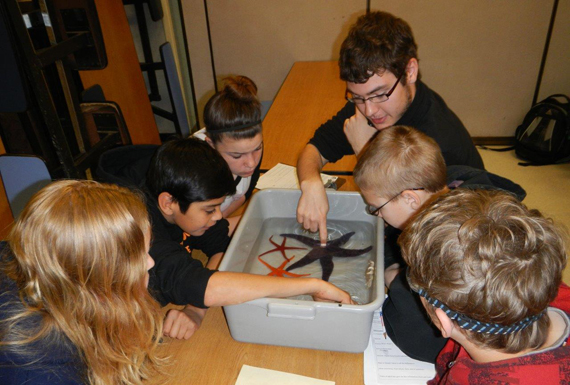
Friday Harbor Labs (FHL) Science Outreach Program staff are looking forward to their 15th year of engaging local K-12 students from San Juan Island School District and Spring Street International School in scientific processes. This school year we will work with over 700 students and 23 teachers in the classroom, lab, field or onboard the R/V Centennial.

FHL Helps Local Emergency Services (EMS) with a Drill
By Pema Kitaeff
This past May, local EMS conducted an emergency drill in FHL's Lab 2 which was a surprise to most of the responders. Some FHL students and researchers volunteered to stage themselves as victims of an "unknown hazard," and gave our local emergency crews a huge challenge with the number of victims we presented. Three ambulances, one fire truck, and multiple personal vehicles belonging to volunteer Emergency Medical Technicians (EMTs) responded to the scene.

Advancement Board Chair Report
By Kevin Schofield
It’s been another busy summer at the Labs — tons of research, many classes, and a campus full of students. Just how we like it! And yet we shouldn’t forget how much it costs to run a world-class program like this — as well as the burden it puts upon students to find the money to participate.

Honoring Eugene Kozloff
By Lesley Nilsson, Dr. Steve Stricker, and Dr. Megan Dethier
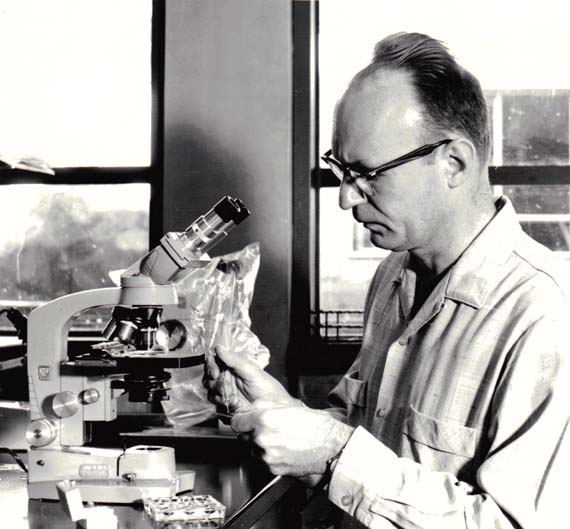
This September, legendary biology professor Eugene Kozloff turned 95 years old. His inspiring instruction to hundreds of FHL students has changed lives, perspectives and even professions.
To honor Professor Kozloff, affectionately known as “Koz”, we are establishing the EUGENE N. KOZLOFF ENDOWED SCHOLARSHIP AT FHL. It seems a fitting tribute that this scholarship will benefit emerging undergraduates as Prof. Kozloff introduced the wonders of science to hundreds of undergraduates!

Sea Star Society Event / Beach Walk
By Rachel Anderson

On August 2nd, Friday Harbor Labs hosted its annual FHL Beach Walk. This event honors FHL Sea Star Society Members (FHL donors who contribute $1,000 or more in a given year), other FHL supporters, and also welcomes new friends and community members. We usually meet at a different location each summer but this year we returned to the Isthmus at Afterglow (near Roche Harbor) by popular demand!

Honoring Pamela Roe
By Rachel Anderson and Rita O'Claire
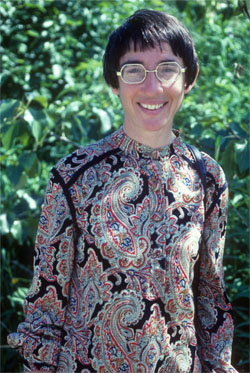
This past spring a group of Pam Roe’s dear friends and colleagues joined together to honor her by establishing the PAMELA ROE GRADUATE STUDENT ENDOWED FUND AT FHL. Pam’s dear friend and fellow FHL student, Rita O’Clair, led the charge and boy did she do an incredible job of soliciting funds! All the while, everyone involved shared wonderful memories about their times with Pam!
The Pamela Roe Graduate Student Endowed Fund will benefit graduate students participating in courses and/or conducting research at the Friday Harbor Laboratories.

Where in the World is Cara Mathison?
By Professor Billie J. Swalla

Most of us met Cara Mathison when Friday Harbor Labs (FHL) moved from the Vice Provost for Research’s office to the newly formed College of the Environment in 2010. Has it really only been five years? It seems much longer that we’ve been listening to Cara’s sage advice and learning how to form long, solid relationships with our FHL supporters.

Love of Kelp
by Jennifer Burnaford
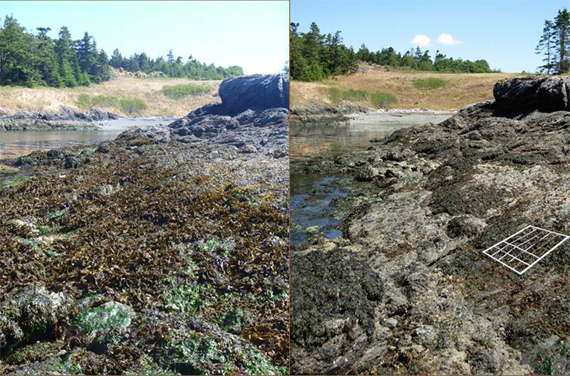
I love kelp, and I am particularly fond of the intertidal kelp Saccharina sessilis (formerly Hedophyllum sessile: commonly known as the sea cabbage). Saccharina’s unique morphology (multiple thick blades emerging directly from a single root-like holdfast) creates a stable canopy over a rocky bench during low tide. A single blade blocks 97% of ambient sunlight (Burnaford and Vasquez 2008), and the area under the canopy can be 13°C cooler than open rock surfaces (Burnaford 2004). Many intertidal animals rely on this cool dark environment for protection from harsh low tide conditions (e.g. ochre sea star Pisaster ochraceus [Burnaford and Vasquez 2008] and black chiton Katharina tunicata [Burnaford 2004, Burnaford et al. 2014]). The kelp also affects other seaweeds, as only select species can tolerate the low light levels under the canopy (Dayton 1975). Saccharina truly lives up to the label ‘foundation species’ (Dayton 1972), because it structures the entire community.

A New Visualization Tool for FHL
by Adam Summers and Beth Brainerd
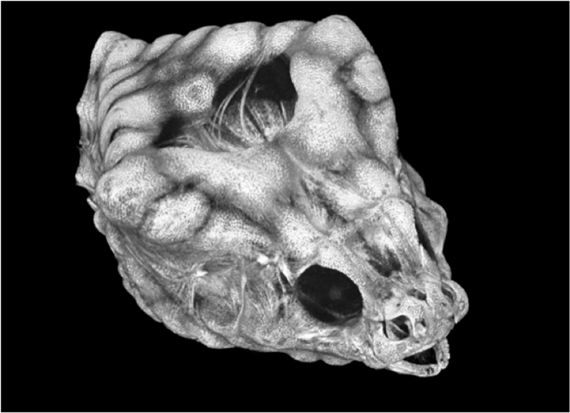
Recently, a cutting edge micro CT scanner was ordered for the Karel F. Liem Bioimaging Facility. The Bruker Skyscan 1173 can image specimens up to 140mm in diameter and 200mm in length with a resolution of 7μm. That is good enough to pick out tiny bone cells in a specimen the size of a can of tomatoes. The machine will have a special stage that can load the specimen with as much as 400N of force before scanning. This could be used to scan a shell before and during the application of a ‘bite force’ to see how the structure rearranges when stressed. The scanner boasts a 130kv energy source which makes it appropriate for biology and for paleontological specimens — which are nearer geology than bone or shell.

Mid-Life Refit for R/V (Research Vessel) Centennial: Please help!
By Kristy Kull
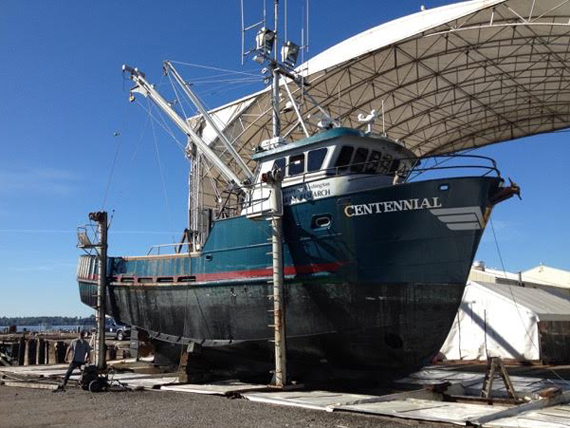
Friday Harbor Lab's 58-foot research vessel was built in 1990 and worked several Alaskan fisheries until she was purchased by FHL in 2002, converted for research, and re-christened Centennial in celebration of FHL's 100th anniversary (Figure 1). After thirteen years in the service of science, m'lady is tired: this Spring the hydrographic (data-conducting) cable broke and jeopardized $60K of water sampling equipment, and the primary generator reached the end of its (extravagantly long) life. These events, added to the rust factors that had accumulated in the nooks and crannies of a 25-year-old steel boat, made it clear that we needed to give the vessel some tender, loving care (TLC). With the support of UW Oceanography and the College of the Environment, Doug Russell (Manager of Marine Operations) and Ray McQuin (retired Captain of the R/V Barnes) came to FHL to give Centennial some close attention and advice. Their recommendations ranged from simple and extraneous fixes to fundamental/major work.

In the News
• UW News article on clingfish research being done at FHL
• UW Today article on students' findings on seastar immune responses to the wasting
disease, from FHL's Ecology of Infectious Marine Diseases course
• UW News article on FHL's Science Outreach Program
• Washington Sea Grant article on ocean acidification research being done by Emily
Carrington's lab
• FHL Zoobot student Susan Harris



